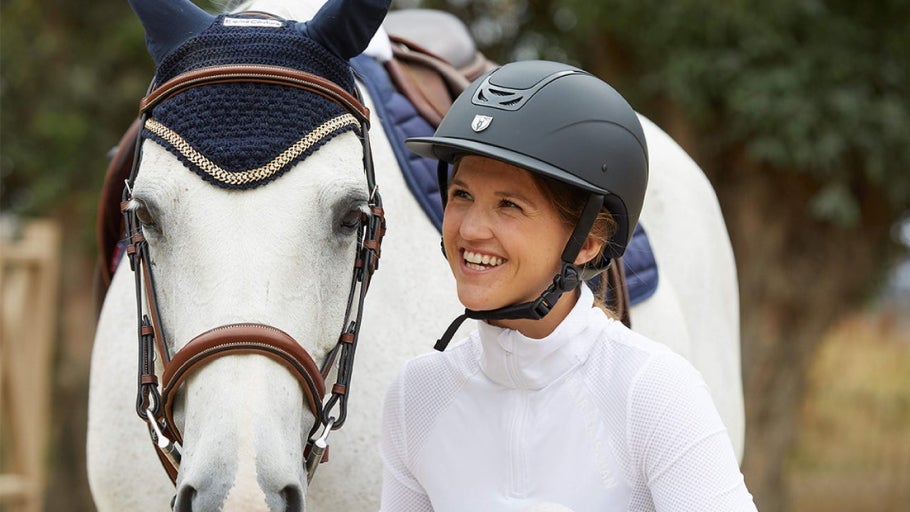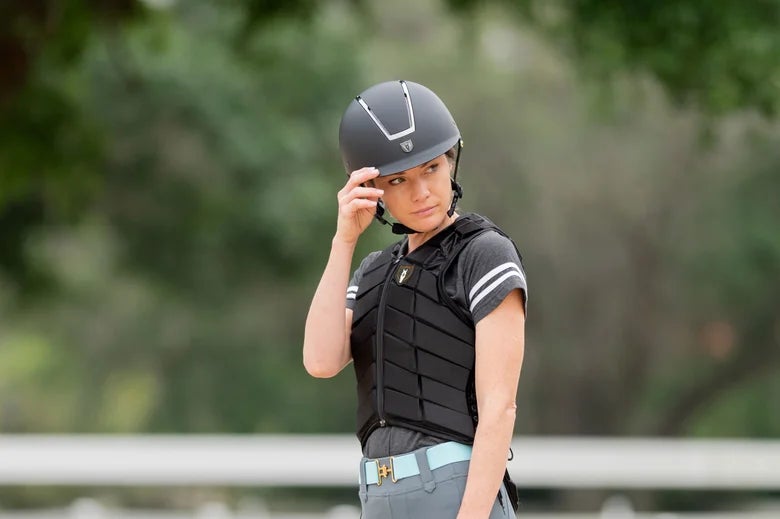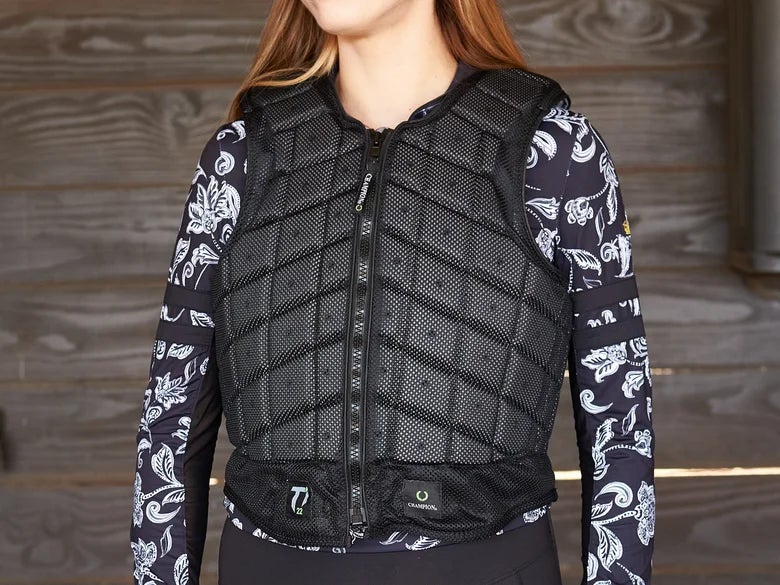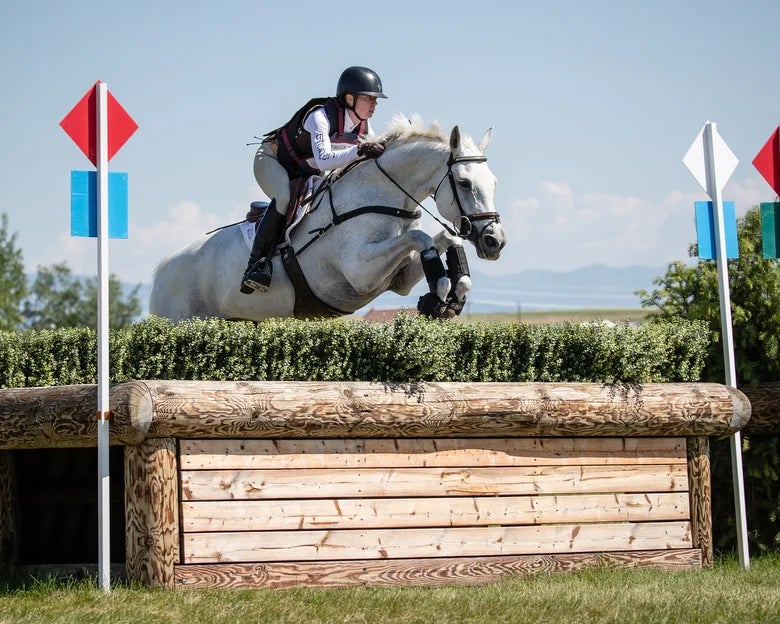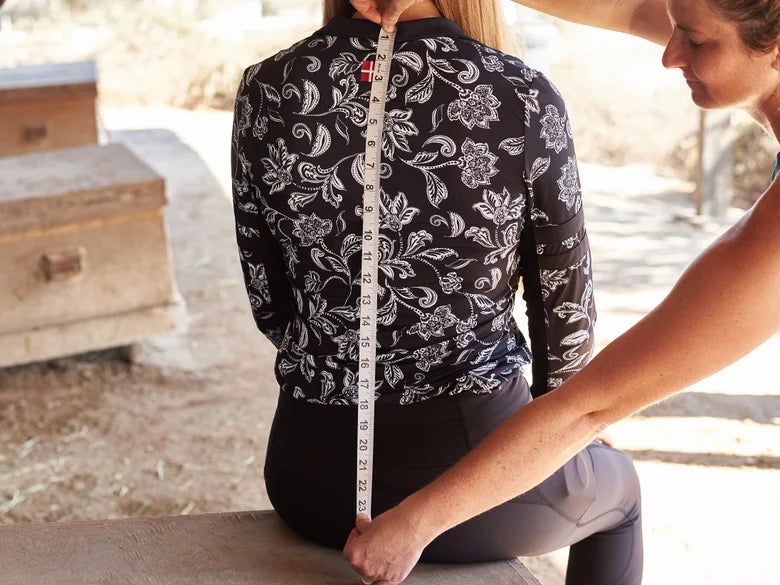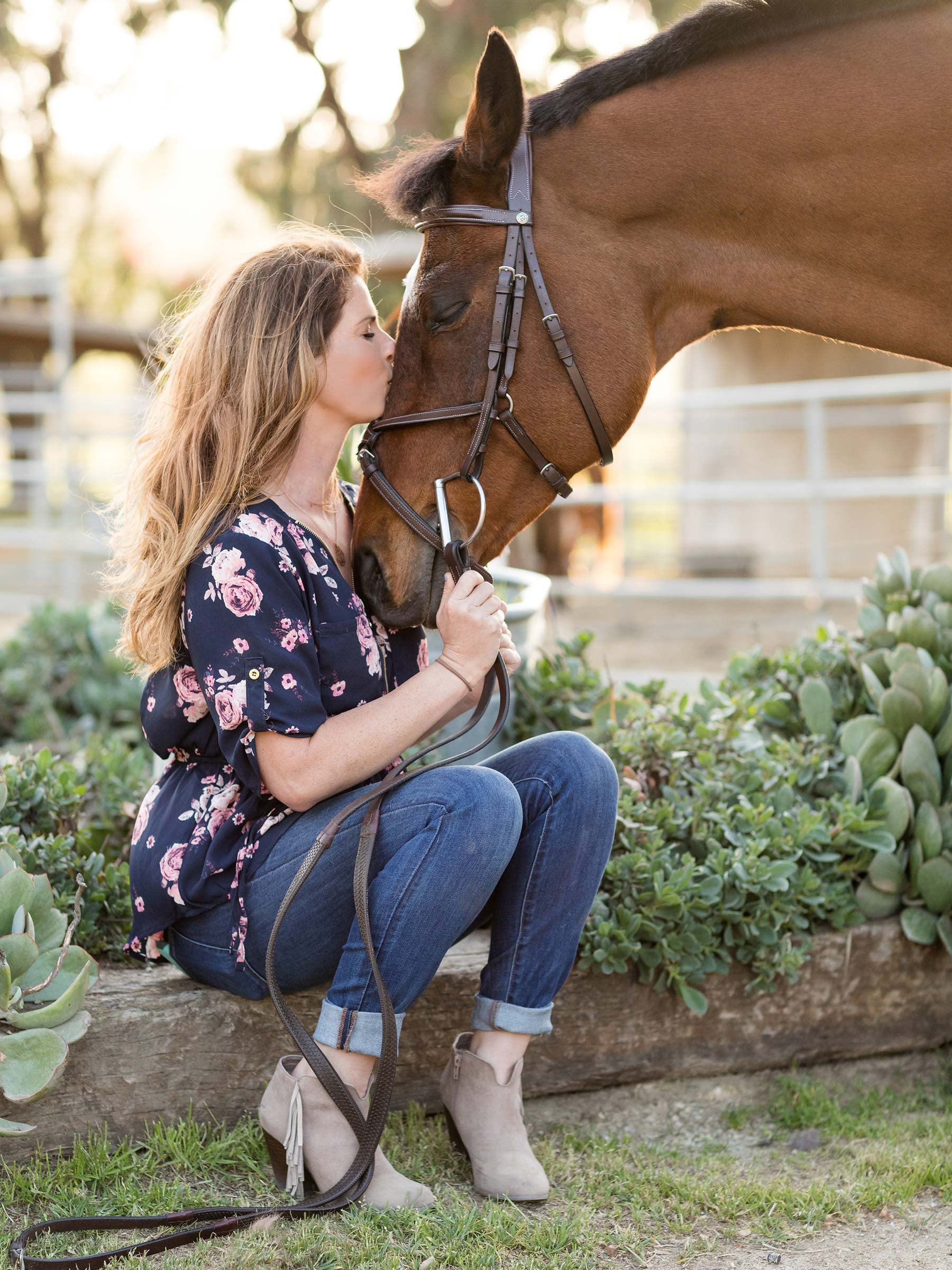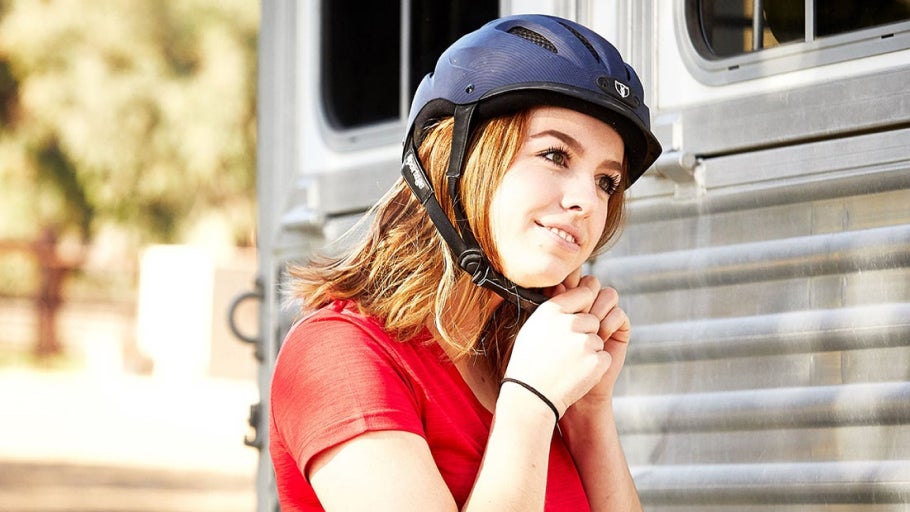
Riding Safety Vest Guide: Everything You Need to Know
In 1986, concerns about concussions and head injuries resulted in mandatory protective helmet use for competitors less than 18 years old. Subsequent rule changes, as well as the equestrian community’s consensus, resulted in the near-universal helmet use we see today. Ongoing safety issues have led to an expansion of riders’ safety equipment beyond the helmet. Leading the way has been the three-day eventing community, which requires body protectors for the cross-country phase of competitions. More recently, self-inflating air vests have become a common piece of supplemental safety gear in many disciplines. Like all safety gear, protective equestrian riding vests are only effective when appropriately sized, correctly used, and properly cared for.
In this article, we will cover why you might want to wear a safety vest, how they work, how to properly size and fit a vest, and more!
Reasons to Consider Using an Equestrian Safety Vest
Equestrian sports involve inherent risks. While nothing can entirely eliminate such risks, properly-fitted safety equipment can minimize them. Today, most riders wear helmets to reduce the risk of head injuries. Similarly, safety vests can reduce injuries from an 'involuntary dismount' or other fall. Adding a safety vest can help you feel confident and secure in the saddle, especially when riding younger or green horses.
Safety vests are not just for beginners. More and more, professionals and highly experienced amateurs are opting to wear safety vests while schooling and in the show ring. Like helmets, safety vests may become a piece of required equipment across a range of equestrian disciplines in coming years.
How Do Equestrian Safety Vests Work?
Traditional Riding Body Protectors
Traditional riding body protectors are usually made with high-density foam panels in the front and back with side laces or straps to keep panels in place. The foam panels are designed to dissipate the impact of a fall by absorbing shock. These body protectors have been shown to reduce injuries to the torso and reduce the frequency of rib fractures.
While traditional body protectors protect the torso area (abdomen, internal organs, chest, and ribs), they have their limitations. They do not offer direct spinal protection, nor do they protect from crushing injuries, such as when a horse rolls over on its rider.
Equestrian Air Vests
There are several manufacturers offering equestrian air vests today, and while the designs vary somewhat, the principle of how they work is similar. The inflatable vests have a lanyard or 'leash' that attaches to the saddle. When a rider is thrown from the saddle, the lanyard triggers an activation device that punctures a canister of compressed air, instantly inflating the vest before the rider hits the ground. Air vests are designed to reduce 'crush' injuries when riders hit the ground hard or when a horse lands on top of the rider during a fall.
As noted above, traditional body protectors are required for eventers during the cross-country phase, and they are permitted—but not required—in most other disciplines. There is no requirement for air vests in any discipline. If a rider wishes to use an air vest for cross-country, they must still wear a traditional body protector underneath the air vest.
How to Size Riding Protective Vests & Equestrian Air Vests
Traditional Riding Body Protectors
Traditional body protectors should be fitted wearing clothing you intend to ride in. Because a body protector is meant to fit closely to your torso, most riders generally wear it over lightweight clothing, such as a riding shirt, jersey, or t-shirt. If you ride in a colder climate, plan to wear heavier garments and outerwear on top of your body protector.
Different manufacturers suggest slightly different measurements on their size charts, although chest, waist, and back lengths are the most common. An accurate chest measurement is very important, regardless of the brand. The chest measurement is paramount because body protectors are typically the least adjustable in this area. Most body protectors allow for adjustments in other areas (length can be adjusted through tabs at the shoulders, and the waist can be adjusted via side laces or closures).
Follow these basic steps to determine the correct size body protector. If you wear a sports bra or compression top when you ride, wear this same garment for your measurements. Have a friend help you so that the measurements are accurate; it’s difficult to correctly measure oneself.
- Chest Measurement: Run the tape measure around the widest point of your chest. Make sure the tape is level and snug, but not tight. The chest measurement is the most important figure in determining body protector sizing.
- Waist Measurement: Run the tape measure around your natural waist. Make sure the tape is level and snug, but not tight. Note, your waist measurement is only a guideline as most body protectors can be adjusted at the waist.
- Length/Back Measurement: This measurement tends to be manufacturer specific. Some request a seated spine measurement. For this, sit in a chair (or your saddle) and run the tape measure from the base of the back of your neck to the base of your spine. You may either take the measurement two to four inches above the seat or subtract two to four inches from the full spine measurement. This is to avoid interference of the bottom of the vest with the saddle. Alternatively, some manufacturers ask for a measurement that runs from the front of your natural waist, over your shoulder, to the back of your waist.
Finally, compare your measurements with the manufacturer’s body protector size chart, choosing the size that most closely matches your measurements. If your measurements fall between sizes, choose the smaller size, as body protectors should fit snugly around your torso. For more help, see our helpful protective vest sizing and fit video below:
Equestrian Air Vests
Air vests are typically designed to fit a little loosely, as they need room to inflate. Many manufacturers suggest four inches (about the size of your fist) between your body and the vest. Having the correct fit ensures you get a tight air 'hug' when the vest inflates. If the vest is too tight, it will be uncomfortable when deployed. If it’s too loose, the vest may shift and not provide adequate protection.
Air vest manufacturers typically request three measurements:
- Chest Measurement: Run the tape measure around the widest point of your chest. Make sure the tape is level and snug, but not tight.
- Waist Measurement: Run the tape measure around your natural waist. Make sure the tape is level and snug, but not tight.
- Length/Back Measurement: This measurement tends to be manufacturer specific. Some request a seated spine measurement. For this, sit in a chair (or your saddle) and run the tape measure from the base of the back of your neck to the base of your spine. Alternatively, some manufacturers ask for a measurement that runs from the front of your natural waist, over your shoulder, to the back of your waist.
Compare your measurements with the manufacturer’s air vest size chart, choosing the size that most closely matches your measurements. If your measurements fall between sizes, choose the larger size, as air vests need room to expand during deployment.
Can Riding Safety Vests be Combined?
Some riders combine these safety devices. Your traditional body protector should be worn underneath your air vest to allow each device to do its job. If you plan to wear an air vest over a traditional body protector, take your air vest measurements while wearing your body protector.
Body Protector Testing & Certifications
As an established and required piece of safety equipment, body protectors are required to meet stringent standards. In the U.S., the Safety Equipment Institute (SEI) is responsible for maintaining American Society for Testing and Materials (ASTM) standards for equestrian safety equipment.
ASTM F1937 standard specifies requirements for body protector assembly, including the extent and form of the protective material, as well as the dimension, sizing, and body coverage provided. Testing procedures include a shock attenuation test, a penetration and deformation test, an impact sites test, a padding separation test, and a closure test. These tests are conducted in four conditions: ambient temperature, low temperature, high temperature, and water immersion.
Given their relative newness, the standard-setting infrastructure for air vests is in its early stages. Currently, there is only one standard specific to air vests: SATRA M38. SATRA M38 includes testing criteria established by SATRA, U.K.-based independent research and testing organization. Air vests are often also certified to CE EN 13158, a more general European Union standard for protective riding clothing. As air vests become more common, new standards set by U.S.-based organizations are anticipated.
Cleaning & Maintainence of Safety Vests
Body protectors rely on the impact-absorbing qualities of foam. Since foam deteriorates over time, plan to replace your body protector every three to five years. If you have a hard fall, check your body protector for dents or damage. The foam is designed to expand back to its original shape within about 30 minutes. If a dent persists after this period of time, the body protector’s impact absorption properties have been compromised and it’s time to replace it. Because you don’t know if a used body protector has been damaged, buying one second-hand is not recommended.
Many body protectors may be hand washed using mild soap and air dried (no machine dry). Refer to the manufacturer’s care and cleaning instructions.
Because of their mechanical nature, it is recommended that air vests be serviced by the manufacturer annually, after six inflations, or after a significant fall, even if there’s no visible damage. Most air vest manufacturers strongly recommend against machine washing or dry-cleaning air vests.
Like all equipment, treat any safety vest with care. Don’t leave your body protector or air vest where it could be damaged. Similarly, don’t leave this important safety equipment in a hot car or damp tack room.
With proper care, your protective vests can provide years of safety and peace of mind!
Closing Thoughts
Whether you need a safety vest for a compeition or you’re just looking for some extra protection when riding green horses, wearing one can increase you confidence in the saddle. Although it cannot completely keep you from harm, it can greatly reduce the risk of serious injury to your torso in the event of a fall. For more assistance when picking out the right vest, please reach out to our helpful customer service associates via phone at 1-800-620-9145 or email at info@ridingwarehouse.com!
Related Articles

